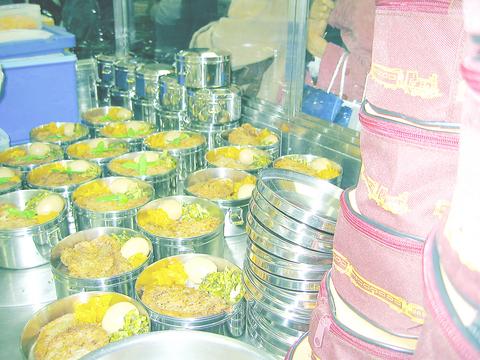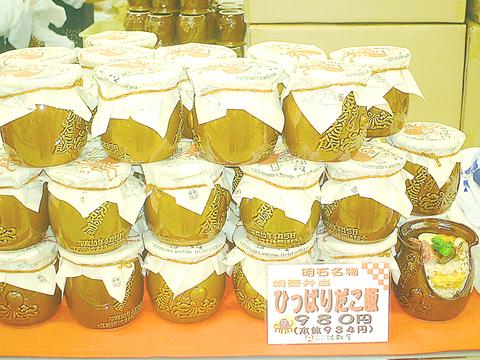A combination of pork chops, cabbage and rice gave Taiwan's often-absent and much-maligned presence on the international stage a flavorsome boost last week, when Taiwan Railway's classic pork chop and vegetable lunchbox (台灣懷舊排骨菜飯便當) became the first international participant to take part in an annual lunchbox show in Tokyo.
Organized by the Japanese hotel and department store chain, Keiouko (

PHOTO COURTESY OF TAIWAN RAILWAY
Attracting huge crowds, the lunchboxes on show are not your run-of-the-mill Styrofoam-packaged variety. Not only do railway stations and mass-transportation companies from across Japan tempt the crowds with regional delicacies, but fancy packaging is also an important aspect of the show.

PHOTO COURTESY OF TAIWAN RAILWAY
Companies use ornately handcrafted bamboo boxes and clay pots looking more like vases than something you'd put your lunch in, to vie for custom, out-sell their rivals and become, quite literally the hottest box in town.
Initially invited to participate in last year's event, Taiwan Railway's Catering Service Department (
While not participating in the event, Chen Ching-piao (
"It being our anniversary year, we were inundated with calls from people who remembered the railway lunchboxes of the 1950s," recalled the catering manager.
"So we decided to produce a limited edition of 1,000, package them in a commemorative aluminum box and sell them on Taiwan Railway's anniversary (鐵路節) on June 8."
All of which proved rather more popular than initially expected. Within three-hours of the railway company's announcing it had produced a limited edition bien dang with fancy packaging and filled with the taste of yesteryear, the company had been inundated with phone calls from people eager to purchase a retro-lunchbox.
And so, packaged in a fancy aluminum container and comprising rice, a pork chop, cabbage and an egg, the Taiwan Railway representative lunchbox was born.
According to Chen, its use of oil from the cooked pork, locally produced cabbage and the presence of dried shrimps in the rice ensured that the lunchbox met with the highest standards and possessed a truly Taiwanese flavor.
With the recipe for success secured, Taiwan Railway began preparing for the event earlier this month. Filling 7,500 aluminum lunch boxes with its special classic pork chop and vegetable meal in readiness for the event that kicked off last Thursday; a day that took Chen's breath away.
"I'd heard the event was popular, but there were huge crowds. You couldn't use the stairwell as a line of people packed it from the venue's basement-one level to the seventh floor where the show was being held," continued Chen.
Made with relatively inexpensive ingredients, Taiwan's entrant in Japan was far from cheap. Priced at the equivalent of NT$450, Taiwan's bien dang was in fact the most expensive lunchbox at this year's show -- its Japanese counterparts averaged NT$350.
Not that this deterred hoards of hungry Japanese from swamping the Taiwan Railway's bien dang stall within minutes of the event's official opening. It did come as somewhat of a surprise for Chen and his fellow Taiwan Railway representatives, however. While expecting some interest they were shocked, yet proud, of what actually happened.
Within 15 minutes of the show opening at 10am on Jan. 9, all 400 Taiwan Railway lunchboxes prepared for that day had been sold.
This was repeated the following day, when all 500 lunchboxes sold out within minutes of the show's opening its doors. And day three was no different, with a total of 700 Taiwan Railway bien dangs being sold long before noon.
"We obviously didn't expect to sell out all 400 that quickly on the first day. And when we sold 500 on the second day and even more on the third day I was amazed," said Chen. "I think the secret of our success lays in the fact that the [lunchbox] is simple yet flavorsome."
The lunchbox has proven so popular that Japanese news reports have been filled with interviews with exasperated visitors who had arrived at the event only to discover that Taiwan's lunchbox had sold out hours before.
Missing the opportunity to sample Taiwan's classic pork chop and vegetable lunchbox, one elderly female Tokyo resident was quoted as explaining that she'd be "getting extra early the following day so as to be able to dine on a Taiwan Railway bien dang."
While Tokyo residents looking for that Taiwanese taste of yesteryear have to set their alarm clocks for ungodly hours, locals have it a bit easier. Due to the lunchbox's runaway success in Japan, Taiwan Railway has launched a special Year End Party Lunchbox (
Costing NT$300, however, Taiwan Railway's lunchbox probably won't become a participant in the ongoing "bien dang wars" being fought out between the nation's connivance stores and more recently McDonalds.

Oct. 27 to Nov. 2 Over a breakfast of soymilk and fried dough costing less than NT$400, seven officials and engineers agreed on a NT$400 million plan — unaware that it would mark the beginning of Taiwan’s semiconductor empire. It was a cold February morning in 1974. Gathered at the unassuming shop were Economics minister Sun Yun-hsuan (孫運璿), director-general of Transportation and Communications Kao Yu-shu (高玉樹), Industrial Technology Research Institute (ITRI) president Wang Chao-chen (王兆振), Telecommunications Laboratories director Kang Pao-huang (康寶煌), Executive Yuan secretary-general Fei Hua (費驊), director-general of Telecommunications Fang Hsien-chi (方賢齊) and Radio Corporation of America (RCA) Laboratories director Pan
The consensus on the Chinese Nationalist Party (KMT) chair race is that Cheng Li-wun (鄭麗文) ran a populist, ideological back-to-basics campaign and soundly defeated former Taipei mayor Hau Lung-bin (郝龍斌), the candidate backed by the big institutional players. Cheng tapped into a wave of popular enthusiasm within the KMT, while the institutional players’ get-out-the-vote abilities fell flat, suggesting their power has weakened significantly. Yet, a closer look at the race paints a more complicated picture, raising questions about some analysts’ conclusions, including my own. TURNOUT Here is a surprising statistic: Turnout was 130,678, or 39.46 percent of the 331,145 eligible party

The classic warmth of a good old-fashioned izakaya beckons you in, all cozy nooks and dark wood finishes, as tables order a third round and waiters sling tapas-sized bites and assorted — sometimes unidentifiable — skewered meats. But there’s a romantic hush about this Ximending (西門町) hotspot, with cocktails savored, plating elegant and never rushed and daters and diners lit by candlelight and chandelier. Each chair is mismatched and the assorted tables appear to be the fanciest picks from a nearby flea market. A naked sewing mannequin stands in a dimly lit corner, adorned with antique mirrors and draped foliage

The election of Cheng Li-wun (鄭麗文) as chair of the Chinese Nationalist Party (KMT) marked a triumphant return of pride in the “Chinese” in the party name. Cheng wants Taiwanese to be proud to call themselves Chinese again. The unambiguous winner was a return to the KMT ideology that formed in the early 2000s under then chairman Lien Chan (連戰) and president Ma Ying-jeou (馬英九) put into practice as far as he could, until ultimately thwarted by hundreds of thousands of protestors thronging the streets in what became known as the Sunflower movement in 2014. Cheng is an unambiguous Chinese ethnonationalist,